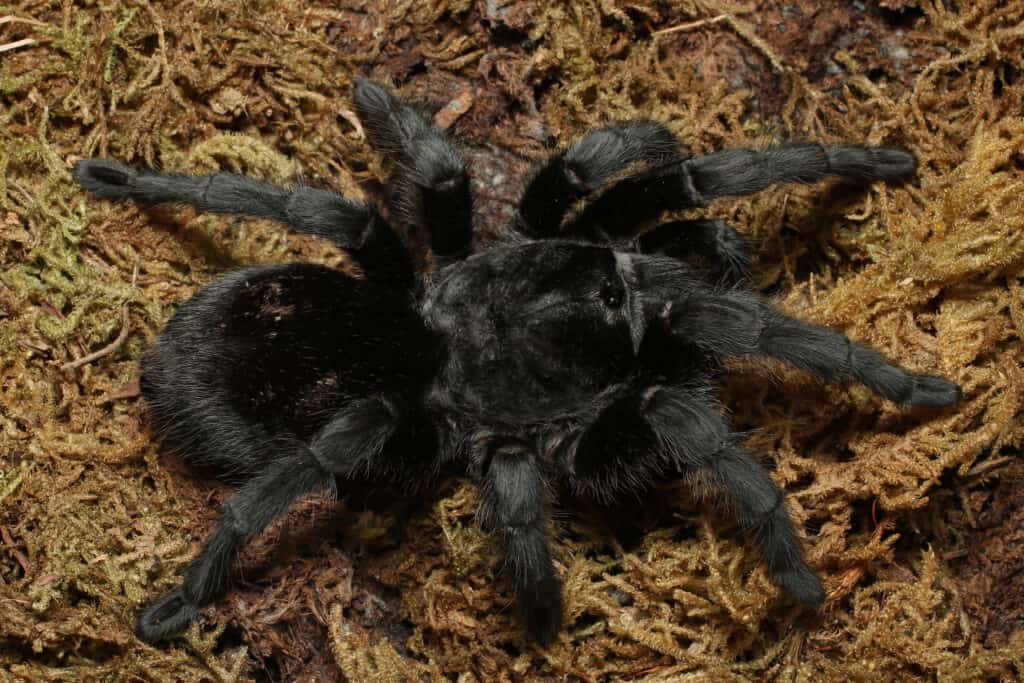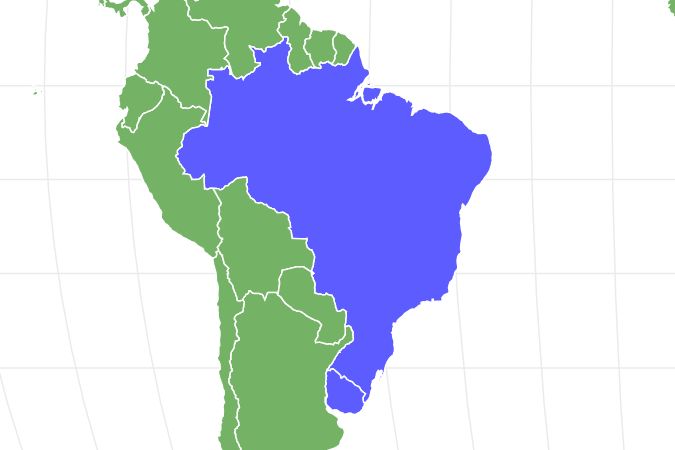Black Tarantula
Grammostola pulchra
They can grow to be 7 inches long!
Advertisement
Black Tarantula Scientific Classification
- Kingdom
- Animalia
- Phylum
- Arthropoda
- Class
- Arachnida
- Order
- Araneae
- Family
- Theraphosidae
- Genus
- Grammostola
- Scientific Name
- Grammostola pulchra
Read our Complete Guide to Classification of Animals.
Black Tarantula Conservation Status
Black Tarantula Facts
- Prey
- roaches, crickets, small mice, small lizards
- Main Prey
- insects
- Name Of Young
- spiderlings
- Group Behavior
- Solitary
- Fun Fact
- They can grow to be 7 inches long!
- Biggest Threat
- Habitat Loss
- Most Distinctive Feature
- Black velvety hair
- Other Name(s)
- Brazilian black tarantula
- Gestation Period
- 2-3 weeks
- Temperament
- easy-going, docile
- Habitat
- grasslands
- Predators
- snakes, lizards, coyotes, fox, tarantula hawks (wasps)
- Diet
- Carnivore
- Average Litter Size
- 600-650 spiderlings
- Lifestyle
- Nocturnal
- Common Name
- Black tarantula, Brazilian black tarantula
- Number Of Species
- 1000
Black Tarantula Physical Characteristics
- Color
- Black
- Skin Type
- Hair
- Lifespan
- Males 6-7 years, Females 20+years
- Weight
- .8-.10 ounces
- Height
- 1-2 inches
- Length
- 6-7 inches
- Age of Sexual Maturity
- 6-7 years for the males
- Venomous
- Yes
- Aggression
- Low
View all of the Black Tarantula images!
They are covered in velvety black hairs.
The black tarantula, also known as the Brazilian black tarantula, is a large black tarantula that can get to be 6-7 inches long. They live in tropical climates and can be found in Brazil and Uraguay. Black tarantulas make burrows in the ground where they live a solitary life with one spider per burrow. Their velvety black coloration makes them a popular pet in the tarantula pet trade.
Amazing Black Tarantula Facts
- These spiders are almost entirely black.
- They are slow growers but when they are full grown can be 6-7 inches long.
- Black tarantulas have weaker venom than other tarantulas.
- They are aggressive eaters and can eat 2-3 large insects a week.
- Female black tarantulas can live more than 20 years.
Black Tarantula Scientific Name
The scientific name of the black tarantula is Grammostola pulchra. They are in the Theraphosidae family of spiders and tarantulas are some of the biggest spiders in North and South America. They are commonly called Brazilian black tarantulas due to living in Brazil.
Black Tarantula Appearance

Brazilian Black Tarantula (Grammostola pulchra) A brilliantly black and large leg span spider, the Brazilian Black tarantula makes for a strikingly pretty pet.
©Dan Olsen/Shutterstock.com
The black tarantula is almost completely black, covered in hairs that look like silky black fur. The tiny hairs cover its back and its legs. They are some of the larger tarantulas and can get to be 6-7 inches long. An average man’s hand is about 7 ½ inches from the tip of the middle finger to the wrist. So that is a pretty good sized spider! They have eight jointed legs that are almost as thick as human fingers. Their bodies are made of the cephalothorax (head and thorax together) and the abdomen.
Black Tarantula Behavior
Black tarantulas seem to move in slow motion, taking their time to get to where they want to go. Their easy going temperament is what makes them a favorite pet when it comes to tarantulas. Black tarantulas are less likely to flick their urticating hairs throw their hairs as a form of defense. The hairs of tarantulas can cause irritation to their predators giving them time to escape.
During the day you will find black tarantulas hiding in their burrows. At night they return to the surface and wait at the entrance of their burrow for dinner to wander by. If an unsuspecting cricket, worm or small mouse gets too close the tarantula will snag it with its forearms and bite it with their fangs. Their fangs release venom that subdues the prey allowing the tarantula to ball it up and wait for the digestive juices to liquefy its prey before sucking up the nutrients.
Black Tarantula Habitat
Their other common name, Brazilian black tarantula lets you know that they live in Brazil, but they can also be found in parts of Uruguay. The climate is tropical with warm weather year-round and moist conditions. They typically live in grasslands where the temperatures are between 60°-70°. Black tarantulas are terrestrial, meaning they live on the ground and not in trees or wetlands. As solitary animals they each make their own burrow and live in their burrows by themselves. The only time they encounter other is during mating season.
Black Tarantula Predators and Threats
There are a few animals that prey on black tarantulas. Even though they are venomous, the venom is not harmful to animals that eat them. Predators that don’t mind eating fuzzy tarantula include snakes, lizards, coyotes and foxes. One of the most unusual threats to tarantulas is the tarantula hawk which is not a hawk but a wasp. These wasps are metallic blue with orange wings. They sting their prey, drag them to a burrow, lay an egg on their abdomen then bury them alive. When the egg hatches the larvae eats the tarantula alive!
Black tarantulas do have a few defense mechanisms. They are most likely to flee, even if it is slowly, then to fight. But they can flick their urticating hairs at a predator or bite with their fangs and inject venom. Remaining deep in their burrows during the day is a protective measure that works well to keep them out of harm’s way as well.
What Eats Black Tarantulas?
The predators of black tarantulas include snakes, lizards, coyotes, foxes and tarantula hawks (a wasp). The black tarantulas are at risk the most at night when they are most active. During the day they spend most of their time deep in their burrows.
What Do Black Tarantulas Eat?
Black tarantulas eat roaches, crickets, small mice and small lizards. They are carnivores and are known to be aggressive eaters. Once they snatch their prey and inject them with digestive juices that liquefy it, they aggressively slurp up their insides. They can survive for quite a while without eating but typically eat 2-3 insects a week.
What is the Conservation Status of Black Tarantulas?
Black tarantulas are not listed by the IUCN as a threatened species. They are popular in the pet trade and it is expensive to purchase a female black tarantula. Some countries have decided to ban the trade of this beautiful species. Be sure to review the laws in your country and work with a reputable breeder if you decide to keep one as a pet of your own.
Reproduction, Babies, and Lifespan
Black tarantulas are solitary animals but when it comes time to reproduce the males leave their burrows in search of the perfect mate. The female black tarantulas are actually quite choosey and will deny a male the chance to mate or worse, eat the courting male. Males are equipped with special pedipalps that they can impregnate the female with all while trying to avoid being eaten.
Female black tarantulas lay 600-650 eggs in one batch. They use their webs to seal the eggs together and place them in a safe area where they can keep watch over them. They frequently turn the batch of eggs which is called brooding. After 2-3 weeks the spiderlings hatch and the mother watches over them for a bit longer. Then the spiderlings disperse and find homes of their own.
Males reach sexual maturity around 6-7 years old. They may mate with several females if they can get away without being eaten. Soon after mating however, the male tarantulas life cycle ends in death. Males have a life span of 6-7 years while females can live to be 20 years old or longer. There are documented cases of female black tarantulas reaching the age of 30 years old. Their long life span is one of the reasons they are a desired pet for spider lovers.
Population
It is difficult to obtain accurate population counts for black tarantulas due to their burrowing lifestyle and the density of the habitat in which they live. They are not listed by the IUCN as a threated species. They are monitored by the exotic pet trade and are banned by some countries to protect their numbers.
Similar Animals
View all 285 animals that start with BBlack Tarantula FAQs (Frequently Asked Questions)
Are black tarantula carnivores, herbivores, or omnivores?
Black tarantulas are carnivores.
What countries do black tarantula live in?
Black tarantulas live in Brazil and Uruguay.
Are black tarantulas good pets?
Yes, black tarantulas are good pets for beginners. They are easy to care for, docile and are less likely to flick their urticating hairs.
Can you pick up a black tarantula?
Yes, you can pick up and hold a black tarantula. They don’t seem to mind being handled which is one of the reasons they make such a good pet.
Do black tarantulas bite?
Black tarantulas can bite but it is rare for them the bite humans. If they do bite it would feel more like a bee sting, but the pain won’t last long.
Are Black tarantulas venomous?
Yes, black tarantulas are venomous but their venom is weaker than most tarantulas. They are not harmful to humans.
Do black tarantulas make webs?
Black tarantulas make webs but not to catch prey like other spiders. They cover the entrance of their burrows with webs.
Thank you for reading! Have some feedback for us? Contact the AZ Animals editorial team.
Sources
- American Tarantula & Animals, Available here: https://www.atshq.org/brazilian-black-tarantula/
- Everything Reptiles, Available here: https://www.everythingreptiles.com/brazilian-black-tarantula/#:~:text=Juvenile%20Brazilian%20black%20tarantulas%20need,sized%20insects%2C%20twice%20per%20week.
- ITIS - Integrated Taxonomic Information System, Available here: https://www.itis.gov/servlet/SingleRpt/SingleRpt?search_topic=TSN&search_value=857271#null

















